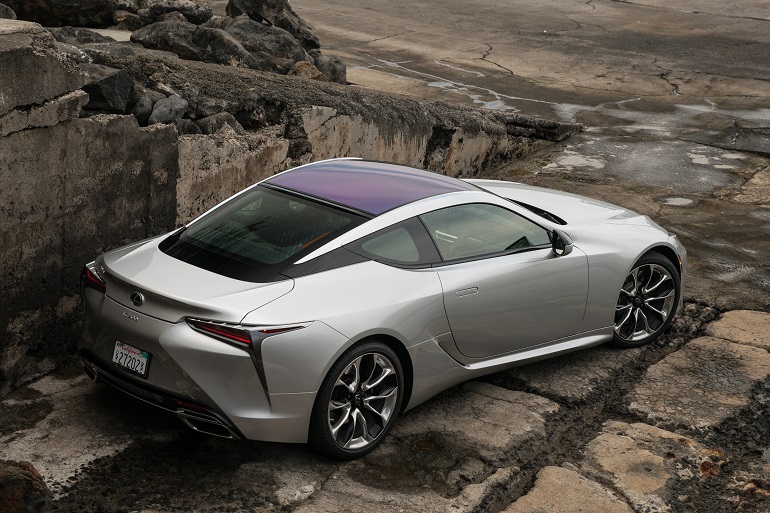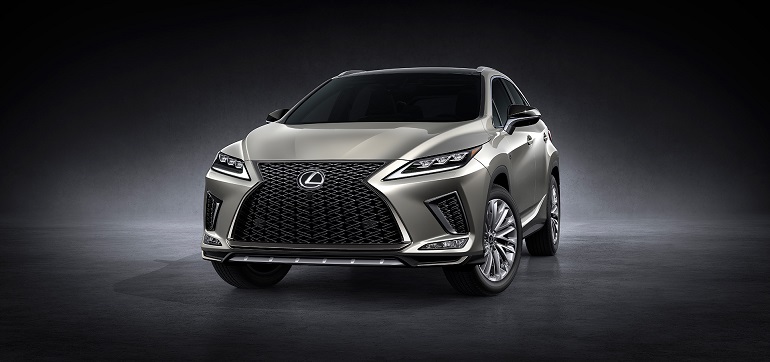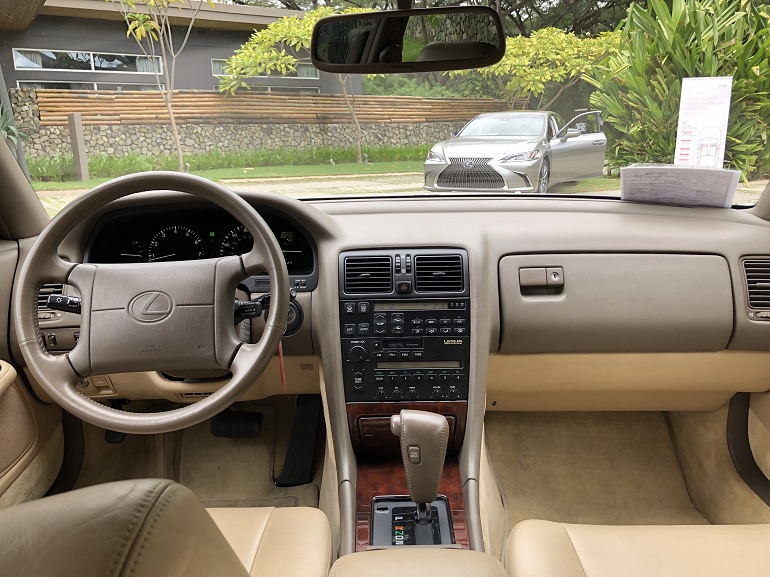GUANACASTE, COSTA RICA – Toyota’s luxury brand Lexus began 30 years ago in one market (the U.S.) with one model (the LS 400) and almost went by another name: Alexis.
Picked from more than 200 names under consideration, Alexis seemed to stick. There was a hang up though. It evoked the name of a TV villainess at the time, the scheming Alexis Carrington of the popular ABC melodrama “Dynasty.”
After some internal debate, the name was softened to Lexus. A data company with a “Lexis” research system subsequently sued, citing a copyright infringement, but Toyota prevailed on appeal and went on to debut its new brand at the North American International Auto Show in 1989. The LS went on sale the next year.
Early-day recollections were aplenty at an extravagant media event held here to commemorate the 30th anniversary of the Lexus brand that ironically wasn’t initially sold in its home country of Japan, only in the U.S. Now Lexus is in 90 markets worldwide.
 Its 1-sedan lineup has grown to 15, including seven SUVs/CUVs and one near-rocket ship sportscar, the LC 500. (LC 500, left)
Its 1-sedan lineup has grown to 15, including seven SUVs/CUVs and one near-rocket ship sportscar, the LC 500. (LC 500, left)
Today’s lineup also includes the RX, which Lexus bills as the first luxury CUV (vintage 1998), blending car-like ride with SUV functionality. It has become the brand’s best seller around the world. Lexus sold about 200,000 of them last year.
The anniversary extravaganza included driving both new and early models. Of the latter, some are low-mileage museum pieces. Others, such as first-generation RX 300s, are high-mileage and sourced from owners.
The spinoff brand entered the U.S. market as a mover and shaker, offering not only a premium product with value-based pricing but also an improved buying experience at dealerships, which by and large, were not particularly customer friendly places three decades ago.
“The 1990 LS 400 was an industry disrupter,” says Michael Moore, Lexus’ senior product manager. “It was smooth, quiet and capable, yet less expensive than competitors.”
In the U.S. luxury segment, Lexus holds the No.3 spot with 298,310 deliveries last year. Although it went after German brands Mercedes-Benz and BMW, they remain the No.1 and No.2 marques. On the other hand, Lexus long ago surpassed General Motors’ Cadillac and Ford’s Lincoln, which once were the top premium brands in the U.S.
Lexus entered the world sensing an opportunity and a vulnerability among competitors. In Mercedes, it saw outstanding quality but pricing that seemed too high. (In response to the new rich kid on the block, Mercedes reformed its price-value proposition.) In Cadillac and Lincoln, it saw quality issues that weren’t atypical of a time when vehicles weren’t as well-built as they are now, luxury or otherwise.
Don Esmond, a former Ford executive who joined Toyota’s U.S. unit in 1982, recalls in a video played here that Lexus initially faced doubters.
“A lot of competitors said, ‘Oh, the Japanese can’t produce a luxury car.’” His reaction to that: “Yes we can, and the icing on the cake is we also delivered a dealer body that would deliver the customer satisfaction.”
 Toyota gave Lexus franchises to select U.S. dealers. Not all of them were Toyota retailers. Instead, the automaker looked not just at stores’ sales but also candidates’ customer satisfaction scores. (Best seller RX sports distinctive spindle grille, left)
Toyota gave Lexus franchises to select U.S. dealers. Not all of them were Toyota retailers. Instead, the automaker looked not just at stores’ sales but also candidates’ customer satisfaction scores. (Best seller RX sports distinctive spindle grille, left)
“Back in the 1980s, there was a sense that dealers didn’t really care about the customer,” Dave Illingworth, the first general manager of Lexus in the U.S., says in a company interview. “There was talk but it really wasn’t put forward into action.”
In the auto industry’s traditional hierarchy of importance, the customer was first, the automaker second and dealers third. Lexus switched that up. Customers remained at the top of the ranking, but dealers were in the second spot, followed by the automaker. It fundamentally changed how dealers were treated and, in turn, conducted themselves.
For the first 81 dealership openings, Lexus received 1,500 applications. Among those applying were Cadillac and Rolls-Royce dealers.
“You had to have high J.D. Power numbers and also be an active owner,” says Paul Williamsen, a Lexus sales and marketing planner who has written two books on the brand’s history.
Currently, Lexus has 150 U.S. dealers. Collectively, they have one of the industry’s highest throughputs or average vehicle sales per store, an important gauge of auto-retailing profitability.
“They know they are picked for specific reasons, a main one being the delivery of a great customer experience,” Williamsen tells journalists here. “They became the most profitable dealers on the planet.
 “One reason for that is there aren’t a lot of them. But they are so receptive when we ask them to do something new.” (Early LS interior, left)
“One reason for that is there aren’t a lot of them. But they are so receptive when we ask them to do something new.” (Early LS interior, left)
Recent initiatives include dealers employing vehicle delivery and technology specialists to thoroughly acquaint buyers with their new purchase. Studies show that the more car owners are familiar with what their vehicles can do, the happier they are.
“We expect our dealers to treat customers right,” Williamsen says. “But for that to happen, we have to treat the dealers right. That’s a core.”
Lexus did and still does extensive dealership training to familiarize retail staffers with new products.
“We do a half-day to full day training per vehicle,” Williamsen says. “When we do a model launch, we train everyone, from the receptionists to the salespeople.”
The idea of a Japanese luxury brand at the time seemed “completely alien – blasphemy of sorts,” says Brian Bolain, general manager-Lexus International Strategic Communications. In the nascent days, he was involved in Lexus pricing.
“Few outside of Lexus supported the idea of a pioneering Japanese brand competing as an equal with the established competitors in luxury,” he says. (Honda’s luxury brand Acura predates Lexus by a few years. Nissan’s Infiniti premium nameplate Acura, like Lexus, also debuted in 1989.)
Launching a premium brand made sense to Toyota on a number of levels. One of them was to offer a premium-vehicle option to keep Baby Boomer Toyota owners in the fold as they became more prosperous.
 As loyal Toyota owners became more affluent, they had no place to go for a luxury vehicle except back to the usual luxury brands, says Moore. (Modern RX interior, left)
As loyal Toyota owners became more affluent, they had no place to go for a luxury vehicle except back to the usual luxury brands, says Moore. (Modern RX interior, left)
The need for a world-class Toyota luxury vehicle became a new priority, focusing on the U.S. market first. Norman Lean, a Toyota U.S. executive, penned a historic memo to the home office: “We need something bigger, and we need it today.”
In 1984, a 15-person planning team was assembled. Its mission was top secret, even within the company. A man on a mission, chief engineer Ichiro Suzuki’s ambitious product-development targets included: 155-mph top speed, 0.28 drag coefficient and 58 decibels at 60 mph.
His engineering team wondered if that were even possible at the time. But he, and they, persevered. Development of the initial LS included 450 prototypes, 2.7 million miles of road testing and the involvement of 1,400 engineers.
Lexus has tried to jazz up its vehicle design in recent years. While few people had questioned the quality and reliability of the vehicles, more than a few rapped the styling as bordering on bland.
“Some could say the first Lexuses were boring,” says Koichi Suga, general manager of Lexus styling.
More recent models look sleeker and more angular in the front and back. Then there’s the Lexus spindle grille, introduced in 2012. It pinches and flares out at the top, more so at the bottom. It’s polarizing; some people like it, others don’t. Either way it’s a strong design statement.
“Now we’re going for ‘wow,’” Suga says of current Lexus styling. “Identity, image and perception are influential to buyers. Today, it is about creating a striking design look of simplicity and elegance, a Japanese sense of beauty and craftsmanship.”
The brand is committed to a range of powertrains, including hybrid-electric and pure electric, says Koji Sato, executive vice president of Lexus International. R&D also includes vehicles powered by hydrogen fuel cells.
The decisions of what goes into production are “based on demand and the background of the market,” Sato says. “We need to consider that and time frames.
He describes himself as a fan of V-8 engines, even they are in fewer and fewer vehicles. “I love the sound and power of a V-8 and I’d love to continue its technology as long as possible.”
At the same time, EVs offer more energy savings and efficiency and “hybrids have great opportunities,” he says, noting Toyota is a “pioneer of hybrid technology.”
Lexus continues to expand its market reach. It now sells vehicles in Costa Rica through the Purdy Motor Group. Unlike some of its Central American neighbors, the country of five million is politically and economically stable and has seen a growing level of affluency.
“Compared to premium European competitors, the Lexus brand is still relatively unknown in many of the smaller global markets,” Bolain says. “The Costa Rican market, like many others in Latin America, is well-positioned to help the Lexus brand continue to grow in the decades to come.”





